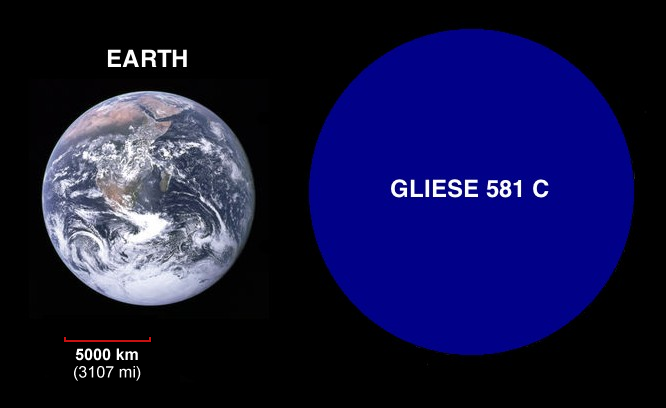Thursday, September 30, 2010
What We Still Dont Know: Why Are We Here?
Wednesday, September 29, 2010
National Geographic: Journey To The Edge Of the Universe
Source
Alien World Tour: The Exoplanets Around Star Gliese 581
The announcement today of two newfound alien planets circling the star Gliese 581 adds to the nearby solar system's intrigue, further cementing its status as a top candidate to harbor extraterrestrial life.
Monday, September 27, 2010
Naked Science: Living on the Moon
Labels:
Exploration,
Future,
NASA,
National Geographic Channel,
Scientists,
Space,
Technology
Sunday, September 26, 2010
Drunvalo Melchizedek: Perspective on Today (2008)
WHAT IS HAPPENING?
WHAT IS HAPPENING?
Drunvalo is the author of four books including The Ancient Secrets of the Flower of Life, Volumes I and II, Living in the Heart and his newest one, Serpent of Light. These books have been published in 29 languages and reach out to over one hundred countries throughout the world.
Drunvalo also founded the Flower of Life Workshops with over 300 trained and certified facilitators teaching in over sixty countries.
He is consultant for the international Internet magazine, Spirit of Ma’at, http://www.spiritofmaat.com with over 1 million viewers each year.
Drunvalo is a world traveler and has given workshops, seminars and lectures on sacred geometry, human energy fields, spirituality, meditation and living in the heart in 45 countries.
His meditation with the angels and his work with prana and energy healing has helped tens of thousands of people. Drunvalo has expressed that healing in these areas are of extreme importance for the difficulties with one's own body often stops us from continuing on our spiritual path. His research on the 3rd dimension with natural products and methods to help heal Mother Earth and all life forms is also a major focus in his life.
Saturday, September 25, 2010
Reverse Combustion: Can CO2 Be Turned Back into Fuel?
Various efforts are underway to find a cheap, efficient and scalable way to recycle the greenhouse gas carbon dioxide back into the hydrocarbons that fuel civilization

SOLAR FUELS: Using this giant dish made of mirrors, Sandia scientists concentrate sunlight on a specially designed solar fuel generator that can break down CO2 and water. Image: Photo by Randy Montoya / Sandia National Laboratories
But by 2003, Chao's successor in the Princeton lab of chemist Andrew Bocarsly was deeply interested in finding a solution to the growing problem of the CO2 pollution causing global climate change. Graduate student Emily Barton picked up where he left off and, using an electrochemical cell that employs a semiconducting material used in photovoltaic solar cells for one of its electrodes, succeeded in tapping sunlight to transform CO2 into the basic fuel.
"The dominant thinking 10 years ago was that we should bury the CO2. But if you could efficiently convert it into something that we wouldn't have to spend all that money and energy to put into the ground, sort of recycle it, that would be better," Bocarsly says. "We take CO2, water, sunlight and an appropriate catalyst and generate an alcoholic fuel."
He adds: "We didn't have some brilliant insight here. We had some luck." Luck that venture capitalists are now trying to turn into cash flow via a start-up known as Liquid Light.
Turning CO2 into fuels is exactly what photosynthetic organisms have been doing for billions of years, although their fuels tend to be foods, like sugars. Now humans are trying to store the energy in sunlight by making a liquid fuel from CO2 and hydrogen—a prospect that could recycle CO2 emissions and slow down the rapid buildup of such greenhouse gases in the atmosphere. "You take electricity and combine CO2 with hydrogen to make gasoline," explained Arun Majumdar, director of the Advanced Research Projects Agency–Energy (ARPA–e) that is pursuing such technology, at a conference in March. "This is like killing four birds with one stone"—namely, energy security, climate change, the federal deficit and, potentially, unemployment.
"When these new technologies get commercialized, those jobs always end up in the U.S.," argues chemical engineer Alan Weimer of the University of Colorado at Boulder, who is working on such solar-fuel generators. Adds chemist Michael Berman of the U.S. Air Force Office of Scientific Research, which is funding research into the possibilities of solar fuels, including Bocarsly's work: "The country, and the Air Force, need secure and sustainable sources of energy…. Since the sun provides enough energy for our needs, our goal is to make a fuel using CO2 and sunlight—and maybe water—as feedstocks to produce the chemical fuel that can store the sun's energy in a form that we can use where and when we need."
Editor's Note (9/24/10): This broadcast stated incorrectly that it takes 18 kilowatts to separate hydrogen and oxygen in one gallon of water. The correct term is kilowatt hours, a unit of energy. It also incorrectly stated hydrogen and oxygen molecules, rather than atoms, comprise water.
Source
Colin Andrews: Crop Circles
Part 2
Source
Wednesday, September 22, 2010
Project Camelot. Conference present an Open Discussion on THE SHIFT
PROJECT CAMELOT PRESENTS AN OPEN DISCUSSION ON THE SHIFT, with Jordan Maxwell, Richard Dolan, Cynthia Crawford, Alfred Webre, Bill Ryan, Kerry Cassidy, Rebecca Jernigan, George Green, Miriam Delicado, Robert O. Dean, and Audience Participation. Introducing PROJECT CAMELOT WHISTLEBLOWER TESTIMONY REVEALED!!! Project Camelot's purpose is to provide a vehicle for researchers and 'whistleblowers' to get their stories out. Its mission is to provide researchers, activists and whistleblowers with access to alternative forms of media in order to get the get the truth out, especially in key areas of research and technology; including possible extraterrestrial visitation and contact, time travel, mind control, classified advanced technology, free energy, possible coming earth changes, and revealing secret plans to control the human race. Project Camelot enables activists in paradigm-challenging fields to make a firm statement about their work, their intentions, and their positive state of mind. --- Kerry Lynn Cassidy has a BA in English with graduate work in Sociology, an MBA certificate from the UCLA Anderson Graduate School of Management. After 19 years in Hollywood working for major studios and independent production companies in production, development and new media, she gave all that up and picked up a camcorder and began interviewing whistleblowers and researchers about UFOs and conspircie. She has written a number of screenplays, acquired an option on the movie rights to the Wingmakers story in 2003. --- Bill Ryan has a BSc in Mathematics with Physics and Psychology (Bristol University, UK, 1974), and followed this with a brief stint in teaching. For 27 years he was a management consultant specializing in personal and team development, leadership training and executive coaching. In November 2005 he inaugurated the Project Serpo website, the report of an alleged disclosure, in stages, of a US-alien exchange program which took place over 40 years ago. Bill is currently based in Europe. Kerry Cassidy and Bill Ryan, travel as much as possible in search of true and reliable testimony to answer the most important and perplexing questions of our time. They also have a weekly radio show called Project Camelot Whistleblower Radio on www.AmericanFreedomRadio.com For more information, to view recorded testimonies of whistleblowers, or to make a much-needed DONATION OF SUPPORT please visit WWW.PROJECTCAMELOT.ORG • Produced by www.ProjectCamelot.org at the Awake and Aware Conference on Sept 19, 20, 2009 in Burbank, California • Content recorded by www.LostArtsMedia.com
Source
Monday, September 20, 2010
Project Pegasus: A Conversation with Andrew D. Basiago
Sunday, September 19, 2010
Archaeological Discoveries - Humanity's Origins
Part 2
Part 3
Part 4
Part 5
Labels:
Archaeology,
DNA,
EARTH,
Forbidden Archeology,
Human,
Prehistoric,
Scientists,
Speculation,
Video
Record your entire life with the Looxcie wearable camera

The problem with YouTube is that you can only share stuff you happened to be recording. The Looxcie, a $200 video camera that you wear on your ear, proposes a simple solution: record everything, all the time.
Here's the idea: You wear the Looxcie on your ear and it records everything you see, roughly as you see it. The camera can hold up to four hours of video (in crummy 480×320 at 15fps); when it runs out of space, it starts dumping the oldest footage—it's not made for collecting clips, it's for capturing them in the moment.
When that shareable moment arrives—your cat gets stuck in a vase!—you press a button that instantly makes a clip out of the last 30 seconds and it gets beamed via Bluetooth to an app on your Android phone (other OSes coming by the end of the year). There, you can edit the clip and share it through all the usual services. The app also lets you access all the other footage stored on your Looxcie, allowing you to create longer clips and tweak settings.
If you're the particular species of oversharer who likes the idea of your every move being committed to (computer) memory, or if you want to finally figure out what happens after you drink all those FourLokos, you can pick up a Looxcie over at Amazon for $200.
Source
Saturday, September 18, 2010
An uncomfortable space silence
Successor to Hubble, the James Webb Space Telescope is now slated for launch in 2014. The $5 billion mission is once again plagued by cost overruns, although no one is saying by how much.NASA
WASHINGTON, D.C. — How can astronomers advise NASA on how to trim the costs of developing missions if no one will tell them how much the costliest mission of all, the James Webb Space Telescope, is running over budget?
That’s what Alan Boss, chair of the independent NASA Astrophysics Subcommittee, would like to know. When the subcommittee met in Washington, D.C., on September 16 and 17, Boss and his colleagues already knew that the $5 billion infrared space observatory, the Hubble Space Telescope’s successor now set for launch in 2014, was once again in need of a monetary transfusion.
What Boss wanted to know was how much. But no one in room 3H46 at NASA headquarters was willing to talk dollars and sense — when Boss, an astronomer at the Carnegie Institution for Science in Washington, D.C., asked if anyone in the room could cite a dollar figure, his question was met with a silence as deep as any in the vast empty reaches of intergalactic space.
“That’s a lightning rod,” he declared. The subcommittee — and the public — will likely get an answer around October 1, when a study requested in June by Sen. Barbara Mikulski (D-Md.) is expected to be released. But the silence in the room doesn’t bode well for what the report will contain, Boss said during a break in the meeting.
The next day Ed Weiler, associate administrator of NASA's science mission directorate, said he didn't know how much more JWST would end up costing, but likened the problem to a tsunami crashing on the shore.
"Let's put it this way,” he said. “It's going to cost more."
Fear of making a huge and embarrassing error like the one that produced Hubble Space Telescope's infamously misshapen primary mirror may be causing JWST scientists and engineers to go overboard and do too much testing, Weiler said. The comprehensive report on JWST due next month, led by John Casani of NASA's Jet Propulsion Laboratory in Pasadena, Calif., will cite instances where engineers on the mission may be overzealous in testing equipment.
Testing costs were the focus of a report posted online September 16 by the NASA-commissioned Test Assessment Team. The report recommended several ways that JWST, which gobbles up about 40 percent of NASA’s astrophysics science budget, could cut costs. But the Test Assessment Team wasn’t asked to determine the dollar amount that the project, which will image small extrasolar planets and look back in time to see the birth of the first galaxies, has exceeded its estimated cost. Nor was it asked it to document how those overruns came to be.
Potential delays in launching JWST, which costs about a million dollars each day it sits on the ground, as well as added costs to several infrared-sensitive instruments, could threaten funding for NASA’s newest big-ticket space telescopes and other projects recently recommended by the National Research Council in its 10-year plan for astronomy, NASA officials have acknowledged.
Source
Labels:
Astronomy,
Exploration,
Extraterrestrial Life,
Future,
NASA,
Scientists,
Technology
Computers set for quantum leap
A new photonic chip that works on light rather than electricity has been built by an international research team, paving the way for the production of ultra-fast quantum computers with capabilities far beyond today’s devices.
Future quantum computers will, for example, be able to pull important information out of the biggest databases almost instantaneously. As the amount of electronic data stored worldwide grows exponentially, the technology will make it easier for people to search with precision for what they want.
An early application will be to investigate and design complex molecules, such as new drugs and other materials, that cannot be simulated with ordinary computers. More general consumer applications should follow.
Jeremy O’Brien, director of the UK’s Centre for Quantum Photonics, who led the project, said many people in the field had believed a functional quantum computer would not be a reality for at least 25 years.
“However, we can say with real confidence that, using our new technique, a quantum computer could, within five years, be performing calculations that are outside the capabilities of conventional computers,” he told the British Science Festival, as he presented the research.
The breakthrough, published today in the journal Science, means data can be processed according to the counterintuitive rules of quantum physics that allow individual subatomic particles to be in several places at the same time.
This property will enable quantum computers to process information in quantities and at speeds far beyond conventional supercomputers. But formidable technical barriers must be overcome before quantum computing becomes practical.
The team, from Bristol university in the UK, Tohuku university in Japan, Weizmann Institute in Israel and Twente university in the Netherlands, say they have overcome an important barrier, by making a quantum chip that can work at ordinary temperatures and pressures, rather than the extreme conditions required by other approaches.
The immense promise of quantum computing has led governments and companies worldwide to invest hundreds of millions of dollars in the field.
Big spenders, including the US defence and intelligence agencies concerned with the national security issues, and governments – such as Canada, Australia and Singapore – see quantum electronics as the foundation for IT industries in the mid-21st century.
Computing’s great leap forward
Why quantum computing?
To make use of properties that emerge on an ultra-small scale. “Entanglement” – the ability of subatomic particles to influence one another at a distance – and “superposition” – the fact that a particle does not have a definite location and can be in several places at once – are the two most important properties.
Yes, it’s weird but why is it useful?
Because quantum particles can do very many things at the same time, unlike an electronic “bit” in conventional computing. The use of quantum particles, or “qubits”, permits parallel computing on a scale that would not be possible with conventional electronics.
What particles are you talking about?
Many scientists are working with atoms or ions trapped in ultra-cold conditions. But the latest discovery by the Bristol-led team uses photons – light particles.
SourceHow does a quantum chip actually work?
There are several models. The Bristol version sends “entangled” photons down networks of circuits in a silicon chip. The particles perform a co-ordinated “quantum walk”, whose outcome represents the results of a calculation.
Of course, special software and input-output devices will have to be developed
to make practical use of the device.
What does one TRILLION dollars look like?

We’ll start with a $100 dollar bill. Currently the largest U.S. denomination in general circulation.

A packet of one hundred $100 bills is less than 1/2” thick and contains $10,000.

$1 million dollars (100 packets of $10,000). You could stuff that into a grocery bag and walk around with it.

While a measly $1 million looked a little unimpressive, $100 million is a little more respectable.
It fits neatly on a standard pallet…
It fits neatly on a standard pallet…

And $1 BILLION dollars… now we’re really getting somewhere…

Ladies and gentlemen… I give you $1 trillion dollars…(And notice those pallets are double stacked.)
Friday, September 17, 2010
Interdimensional Beings, Guides and Angels
Bob Lazar radio interview on Coast to Coast AM
Source
Thursday, September 16, 2010
Strato Cruiser airship concept
by Tino Schaedler and Michael J. Brown
by Tino Schaedler and Michael J. Brown
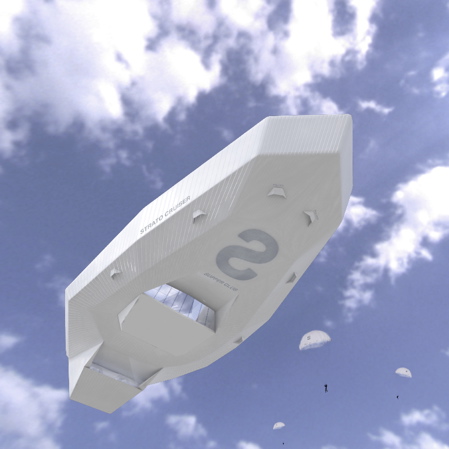
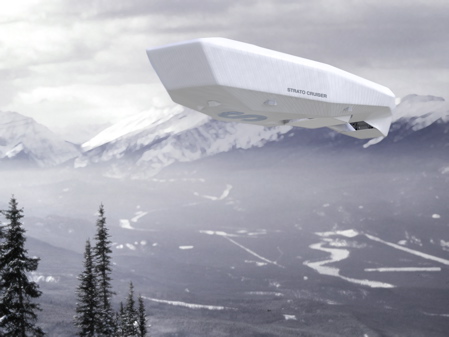

Details from the designers:
–
STRATO CRUISER
concept for a lifestyle zeppelin
by tino schaedler and michael j brown
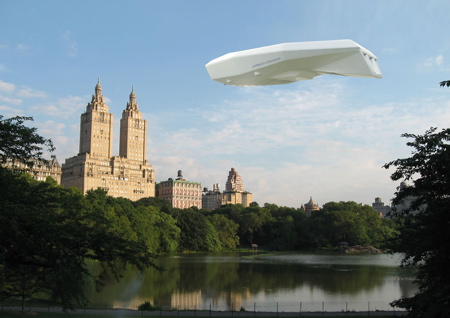
Concept:
Merging the soothing ride of an ocean cruise with Richard Branson’s futuristic visions of space travel, the Stratocruiser offers short, regenerative journeys for the cosmopolitan traveler. The project aims to bring lifestyle and health into travel routines, which have become increasingly compacted and frenzied. Like modern nomads we can again enjoy travel, arriving more refreshed than we left, thanks to incredible views of the worlds most exciting landscapes and cities.

As a fictional partnership with the SupperClub, Stratocruiser adds a new experience to the chain’s clubs, restaurants, ‘On location’ and ‘Cruise’ boats. Guests depart for a full day of spa treatments—massage, personal trainers, yoga classes and beauty care are on offer. The Stratocruiser offers “medium-haul” transits between the Supperclub hubs: transatlantic, transpacific, trans-american or Europe-Middle East routes. With spa, library, and private mini-offices available, the contemporary traveler who seldom has time for a cruise can transform an otherwise exhausting and ordinary journeys into a positive experience.
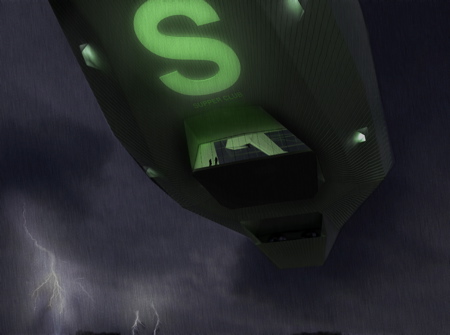
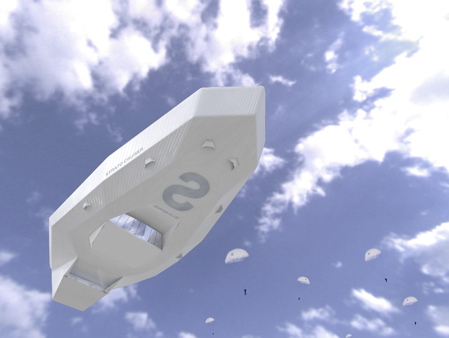
Structure:
With its carbon fiber skin, sectional helium chamber design and photovoltaic cells, the Stratocruiser’s construction brings new levels of safety, speed and ecology to travel. Its “doughnut hole” atrium reinvents the zeppelin concept with a sky lounge on top, the earthward viewing restaurant on the underside and a recreational climbing wall in between. Private suites are sheltered away from public spaces on the ship’s belly, while an advanced propulsion system more than doubles the cruising speed of conventional blimps.
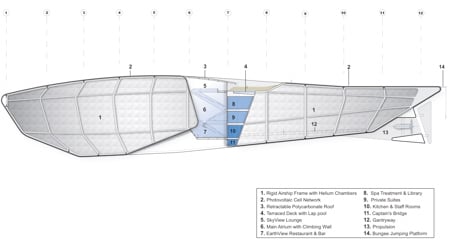
2.Photovoltaic Cell Network
3.Retractable Polycarbonate Roof
4.Terraced Deck with Lap pool
5.SkyView Lounge
6.Main Atrium with Climbing Wall
7. EarthView Restaurant & Bar
8. Spa Treatment & Library
9. Private Suites
10.Kitchen & Staff Rooms
11. Captain’s Bridge
12.Gantryway
13.Propulsion
14. Bungee Jumping Platform
Source
Subscribe to:
Comments (Atom)

